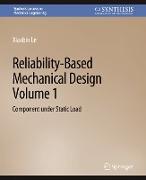Reliability-Based Mechanical Design, Volume 1
BücherAngebote / Angebote:
A component will not be reliable unless it is designed with required reliability. Reliability-Based Mechanical Design uses the reliability to link all design parameters of a component together to form a limit state function for mechanical design. This design methodology uses the reliability to replace the factor of safety as a measure of the safe status of a component. The goal of this methodology is to design a mechanical component with required reliability and at the same time, quantitatively indicates the failure percentage of the component. Reliability-Based Mechanical Design consists of two separate books: Volume 1: Component under Static Load, and Volume 2: Component under Cyclic Load and Dimension Design with Required Reliability.
This book is Reliability-Based Mechanical Design, Volume 1: Component under Static Load. It begins with a brief discussion on the engineering design process and the fundamental reliability mathematics. Then, the book presents several computational methods for calculating the reliability of a component under loads when its limit state function is established. Finally, the book presents how to establish the limit state functions of a component under static load and furthermore how to calculate the reliability of typical components under simple typical static load and combined static loads. Now, we do know the reliability of a component under static load and can quantitively specify the failure percentage of a component under static load.
The book presents many examples for each topic and provides a wide selection of exercise problems at the end of each chapter. This book is written as a textbook for junior mechanical engineering students after they study the course of Mechanics of Materials. This book is also a good reference book for design engineers and presents design check methods in such sufficient detail that those methods are readily used in the design check of a component under static load.
Folgt in ca. 10 Arbeitstagen



